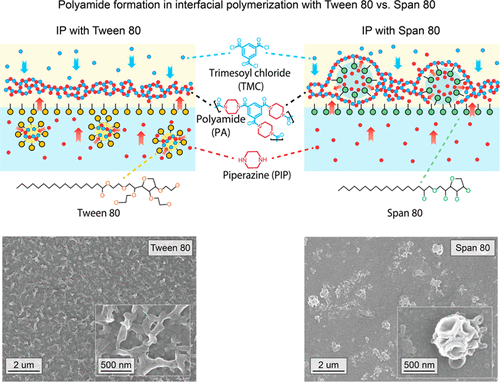当前位置:
X-MOL 学术
›
ACS ES&T Eng.
›
论文详情
Our official English website, www.x-mol.net, welcomes your
feedback! (Note: you will need to create a separate account there.)
Polyamide Nanofiltration Membranes from Emulsion-Mediated Interfacial Polymerization
ACS ES&T Engineering ( IF 7.4 ) Pub Date : 2021-01-08 , DOI: 10.1021/acsestengg.0c00213 Yuanzhe Liang 1, 2, 3 , Xiangxiu Teng 1 , Rui Chen 2 , Yuzhang Zhu 1 , Jian Jin 1, 4 , Shihong Lin 2, 3
ACS ES&T Engineering ( IF 7.4 ) Pub Date : 2021-01-08 , DOI: 10.1021/acsestengg.0c00213 Yuanzhe Liang 1, 2, 3 , Xiangxiu Teng 1 , Rui Chen 2 , Yuzhang Zhu 1 , Jian Jin 1, 4 , Shihong Lin 2, 3
Affiliation

|
Fabrication of nanofiltration (NF) membranes using interfacial polymerization (IP) continues to receive tremendous interest in research and development due to the broad applications of NF in water treatment, wastewater reuse, and industrial separations. Many approaches have been explored to enhance the performance of NF membranes by regulating the IP process. Among these approaches, the use of surfactants has shown strong potential due to its low cost and compatibility with existing infrastructure for membrane fabrication. While the different roles of the surfactants have been increasingly elucidated in recent years, little is known for the role of emulsion formation in the IP process. In this study, we investigate the impacts of nonionic, emulsifying surfactants on the formation, properties, and performance of the polyamide NF membranes. Two surfactants were compared, including the hydrophilic Tween 80, which is an oil-in-water (o/w) emulsifier added in the aqueous solution of piperazine, and the lipophilic Span 80, which is a water-in-oil (w/o) emulsifier added in the hexane solution of trimesoyl chloride. Our results illustrate the effects of emulsions as “vehicles” to facilitate monomer transfer and as “microreactors” for providing additional and distributed interfaces for IP. Depending on whether the surfactants are o/w or w/o emulsifiers, the resulting membranes have unique physicochemical properties and NF performance. In both cases, the addition of nonionic surfactants at low-to-moderate concentrations results in smaller pore sizes and a narrower pore size distribution. Overall, this study provides important insights into how the IP process and the resulting NF membranes are influenced by the formation of emulsions.
中文翻译:

乳液介导的界面聚合作用的聚酰胺纳米滤膜
由于NF在水处理,废水回用和工业分离中的广泛应用,使用界面聚合(IP)制备纳米过滤(NF)膜继续受到研究和开发的极大兴趣。已经探索了许多通过调节IP过程来增强NF膜性能的方法。在这些方法中,由于表面活性剂的低成本和与现有膜制造基础设施的相容性,使用表面活性剂已显示出强大的潜力。尽管近年来已经阐明了表面活性剂的不同作用,但对于IP加工中乳液形成的作用知之甚少。在这项研究中,我们研究了非离子型乳化表面活性剂对聚酰胺NF膜的形成,性质和性能的影响。比较了两种表面活性剂,包括亲水性吐温80和脂溶性Span 80,亲水性吐温80是在哌嗪水溶液中添加的水包油型乳化剂,脂溶性Span 80是油包水的质量比。 o)将乳化剂加入均苯三甲酰氯的己烷溶液中。我们的结果说明了乳液作为促进单体转移的“载体”和作为“提供IP附加和分布式界面”的“微反应器”的作用。根据表面活性剂是o / w还是w / o乳化剂,所得的膜具有独特的理化性质和NF性能。在两种情况下,以中低浓度添加非离子表面活性剂都会导致较小的孔径和较窄的孔径分布。全面的,
更新日期:2021-03-12
中文翻译:

乳液介导的界面聚合作用的聚酰胺纳米滤膜
由于NF在水处理,废水回用和工业分离中的广泛应用,使用界面聚合(IP)制备纳米过滤(NF)膜继续受到研究和开发的极大兴趣。已经探索了许多通过调节IP过程来增强NF膜性能的方法。在这些方法中,由于表面活性剂的低成本和与现有膜制造基础设施的相容性,使用表面活性剂已显示出强大的潜力。尽管近年来已经阐明了表面活性剂的不同作用,但对于IP加工中乳液形成的作用知之甚少。在这项研究中,我们研究了非离子型乳化表面活性剂对聚酰胺NF膜的形成,性质和性能的影响。比较了两种表面活性剂,包括亲水性吐温80和脂溶性Span 80,亲水性吐温80是在哌嗪水溶液中添加的水包油型乳化剂,脂溶性Span 80是油包水的质量比。 o)将乳化剂加入均苯三甲酰氯的己烷溶液中。我们的结果说明了乳液作为促进单体转移的“载体”和作为“提供IP附加和分布式界面”的“微反应器”的作用。根据表面活性剂是o / w还是w / o乳化剂,所得的膜具有独特的理化性质和NF性能。在两种情况下,以中低浓度添加非离子表面活性剂都会导致较小的孔径和较窄的孔径分布。全面的,











































 京公网安备 11010802027423号
京公网安备 11010802027423号